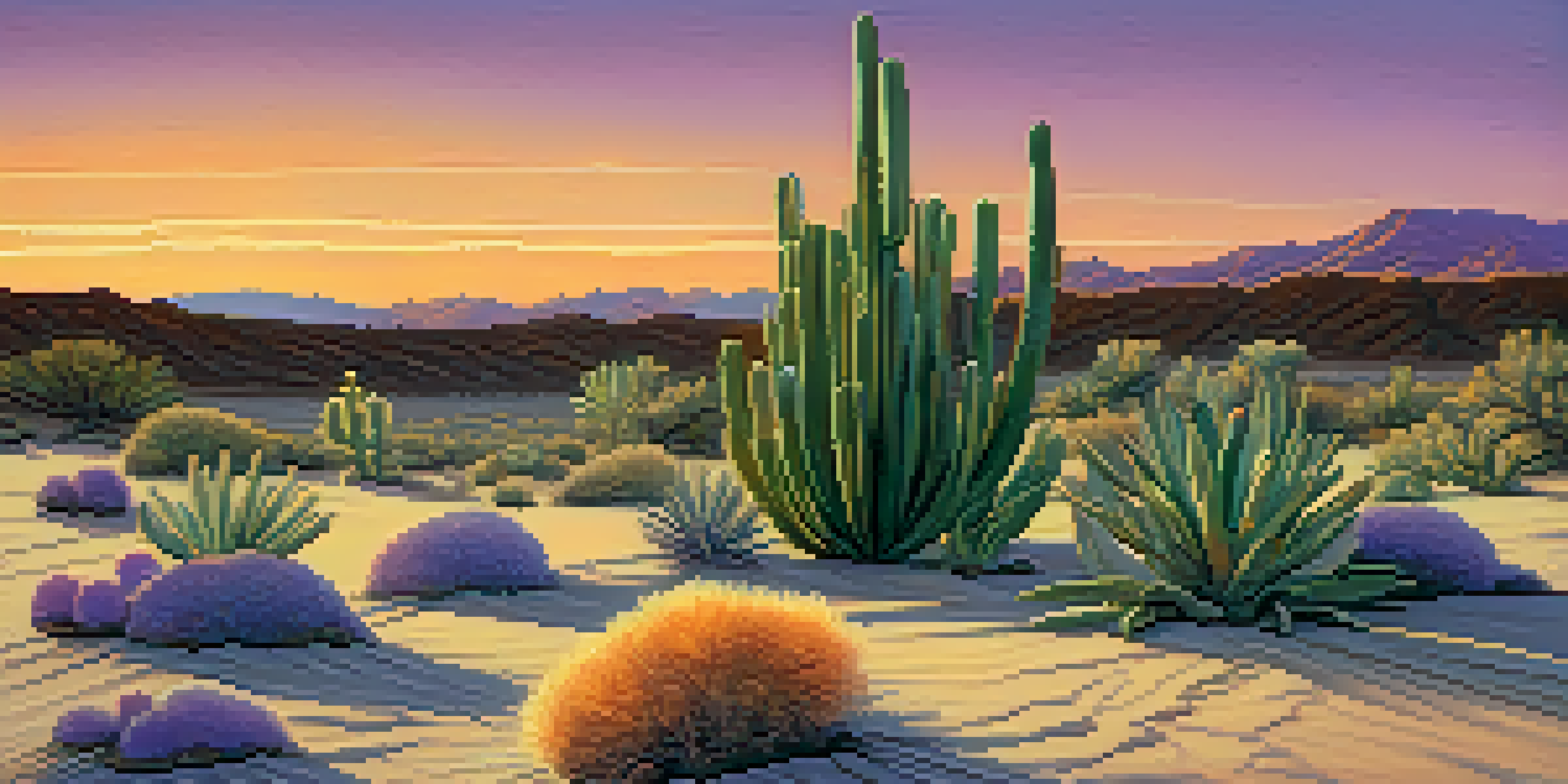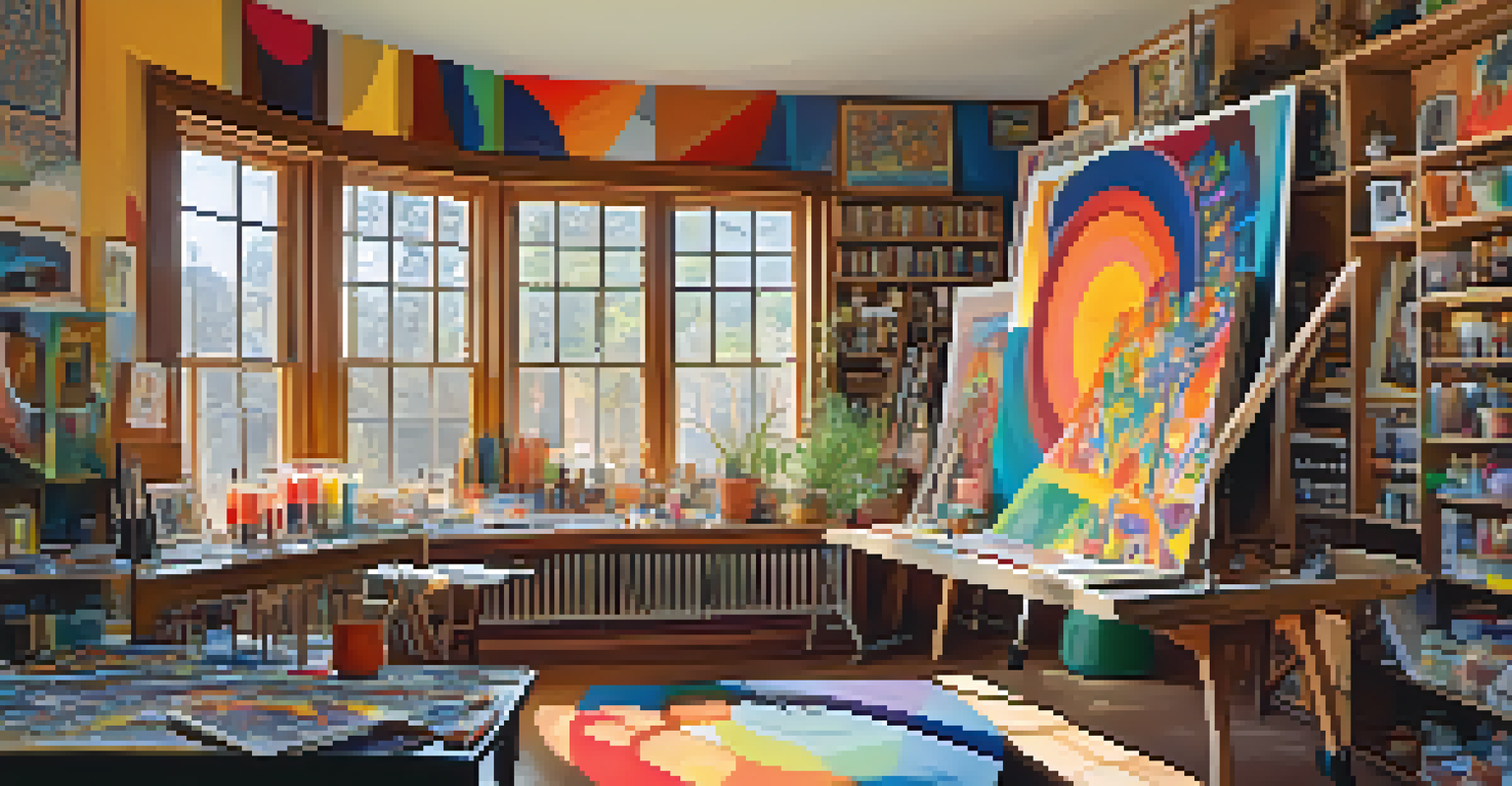Exploring Peyote's Role in Enhancing Artistic Creativity

Understanding Peyote: A Brief Overview
Peyote is a small, spineless cactus native to Mexico and the southwestern United States, famous for its psychoactive properties. Traditionally used in Native American rituals, peyote contains mescaline, a compound that alters perception, mood, and consciousness. This unique plant has been revered for centuries as a medium for spiritual connection and creative inspiration.
The creative process is a process of surrender, not control.
In Indigenous cultures, peyote is often consumed during ceremonies to foster a deeper connection with the universe. Participants frequently report altered states of consciousness, leading to heightened sensory experiences and introspection. Such experiences can open up new avenues of thought, making peyote a fascinating subject for those curious about creativity and artistic expression.
As artists seek new methods to break through creative blocks, peyote presents an intriguing option. Its historical significance and the potential for enhancing creativity have drawn attention in contemporary discussions about the intersection of psychedelics and art.
The Psychological Effects of Peyote on Creativity
Psychoactive substances like peyote can significantly impact the brain's functioning, often leading to increased creative thinking. Many users describe experiences of synesthesia, where senses blend, such as 'seeing' sounds or 'hearing' colors. This blending can inspire artists to explore new techniques, styles, and concepts they may not have considered before.

The altered state induced by peyote can also facilitate divergent thinking, a cognitive process where individuals generate multiple solutions to a problem. This ability to think outside the box is crucial for artists looking to innovate and push boundaries in their work. In this way, peyote may serve as a catalyst for artistic breakthroughs.
Peyote Enhances Creative Thinking
The psychoactive effects of peyote can lead to increased creativity by enabling new ways of thinking and self-reflection.
Moreover, introspection during peyote experiences often leads to profound personal insights. Artists can reflect on their motivations, fears, and aspirations, which can then inform their creative endeavors, resulting in more authentic and meaningful artwork.
Historical Context: Peyote and Artistic Movements
Throughout history, many artists have sought out psychedelics, including peyote, to enhance their creativity. In the 1960s, the counterculture movement embraced various hallucinogens, believing they could unlock new levels of artistic expression. Artists like Alex Grey and Robert Venosa have credited their use of psychedelics, including peyote, with helping to shape their visionary art.
Creativity is intelligence having fun.
This historical intertwining of peyote and art isn't limited to just the 20th century; Indigenous artists have long used peyote as part of their creative and spiritual practices. The rich symbolism and vibrant colors often found in Native American art reflect the profound influence of peyote experiences, highlighting the intertwining of spirituality and creativity.
As we explore these artistic movements and their connections to peyote, it's clear that the cactus has played a significant role in shaping how artists perceive and express their reality.
Contemporary Artists and Their Connection to Peyote
In modern times, several artists continue to explore the creative potential of peyote. They often share their personal stories of how peyote has helped them break through creative walls and access deeper layers of inspiration. For many, it’s not just about the visuals experienced during the trip but also the lasting impact on their artistic journeys.
Contemporary art scenes are increasingly open to discussing the role of psychedelics, including peyote, in creativity. Workshops and retreats focused on psychedelic art therapy are becoming more popular, allowing artists to safely explore their creativity while under the influence of these substances. This trend highlights a growing acceptance of psychedelics as tools for artistic exploration.
Historical Ties to Art and Spirituality
Peyote has a long-standing connection to artistic movements and Indigenous cultures, influencing creativity and spiritual practices.
As these artists share their experiences, a community forms around the idea that peyote can be a valuable ally in the creative process. Their stories serve as a reminder of the profound connection between nature, spirituality, and artistic expression.
The Risks and Considerations of Using Peyote
While peyote may offer creative benefits, it’s essential to approach its use responsibly. Not everyone responds positively to psychedelics; some may experience anxiety or discomfort during their journey. It's crucial for artists to be aware of their mental health and consider whether they are in a suitable mindset before exploring peyote as a creative tool.
Additionally, peyote is a protected plant under various laws, particularly in the United States. Its use is primarily restricted to specific Native American religious practices. Those considering peyote for artistic purposes should be mindful of legal implications and the cultural significance of the plant.
Ultimately, respecting the traditions and histories surrounding peyote is vital. Engaging with it thoughtfully and ethically can contribute to a richer understanding of its role in creativity while honoring the cultures that have long cherished its use.
Alternative Methods to Enhance Creativity
If peyote isn't a viable option for everyone, there are various alternative methods to enhance creativity. Practices such as meditation, yoga, and mindfulness can foster states of relaxation and openness, allowing creative ideas to flow more freely. These techniques can help individuals connect with their inner thoughts and feelings without the need for substances.
Additionally, engaging in nature or exploring new environments can be incredibly inspiring. Artists often find that a change of scenery or immersing themselves in nature sparks new ideas and perspectives. The natural world itself can serve as a muse, offering endless inspiration without the complexities that come with psychoactive substances.
Caution with Peyote Use
While peyote can inspire creativity, it is essential to approach its use responsibly and with respect for its cultural significance.
Finally, collaborating with other creatives can lead to a rich exchange of ideas and motivations. Sometimes, all it takes is a conversation or a shared experience to ignite that creative spark, reminding us that inspiration can come from many different sources.
Finding Balance: Creativity and Substance Use
As we consider the role of peyote in enhancing creativity, it's crucial to find a balance between artistic exploration and responsible substance use. Many artists have found that while psychedelics can offer inspiration, they shouldn't be relied upon as the sole means of creativity. Cultivating other creative practices alongside occasional exploration can lead to a more sustainable artistic journey.
Moreover, understanding the potential consequences of using substances like peyote is vital. While the allure of enhanced creativity is tempting, the unpredictable nature of psychedelic experiences means that artists must tread carefully. Personal growth and artistic expression can flourish through various avenues, not just through psychedelics.

In the end, the journey of artistic creativity is deeply personal and unique to each individual. Whether through peyote or other methods, finding what works best for you is key in unlocking your true creative potential.